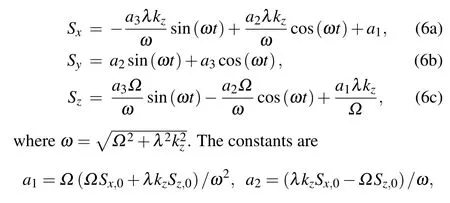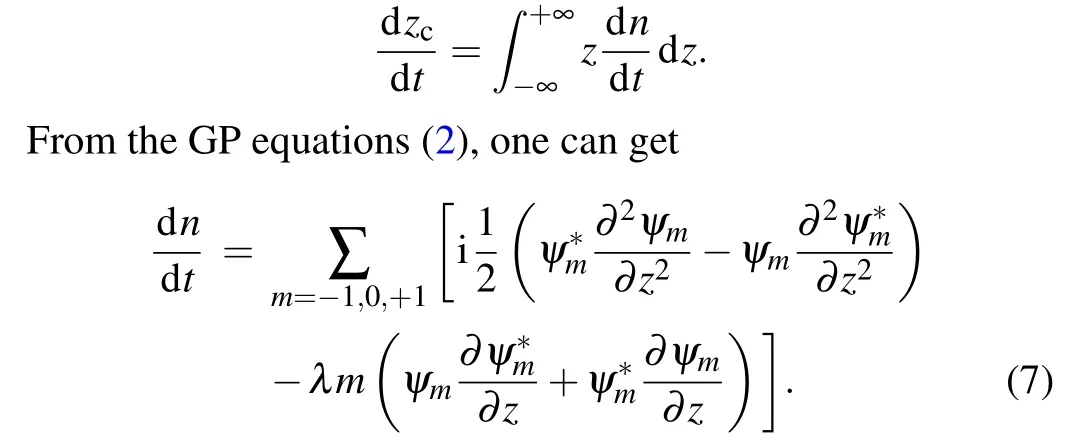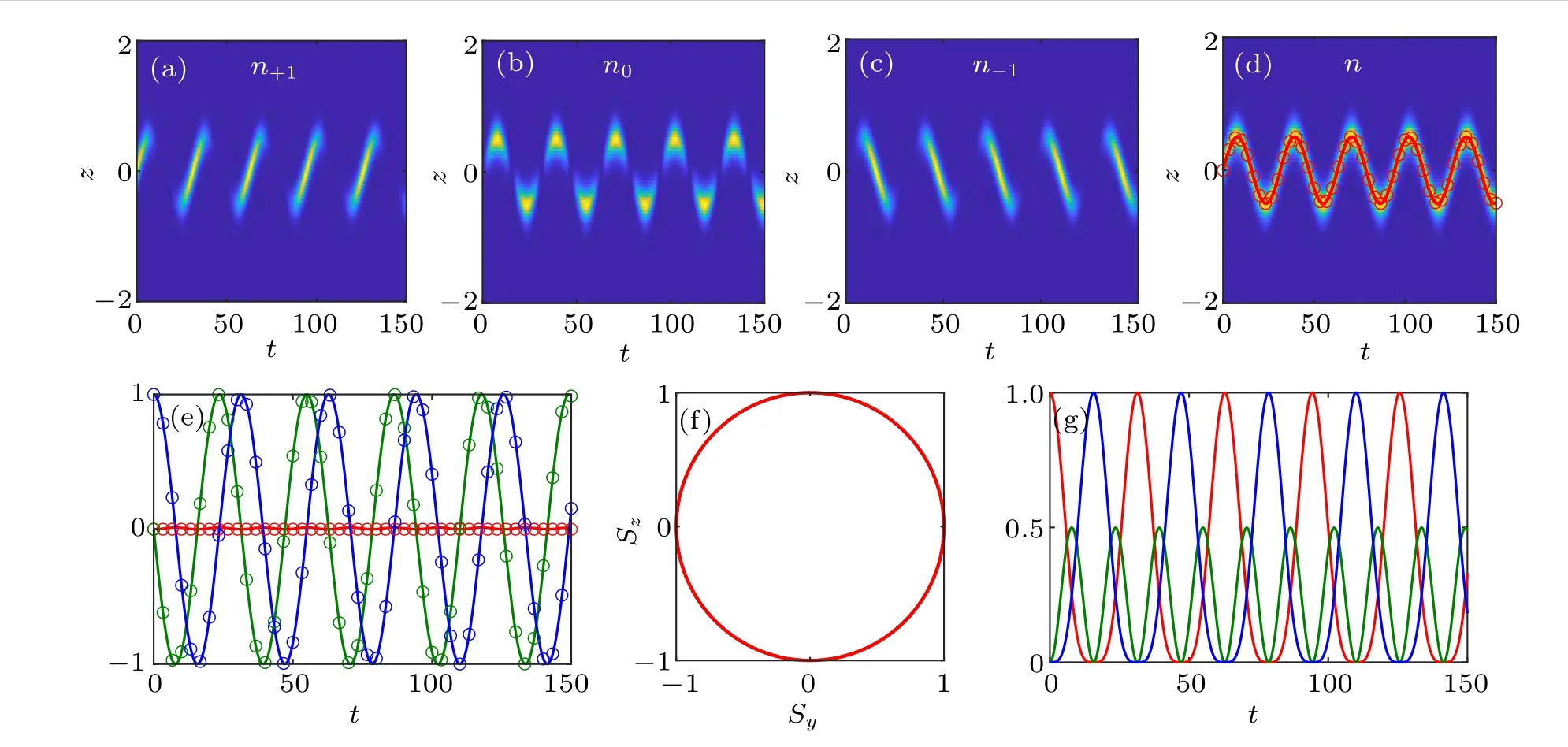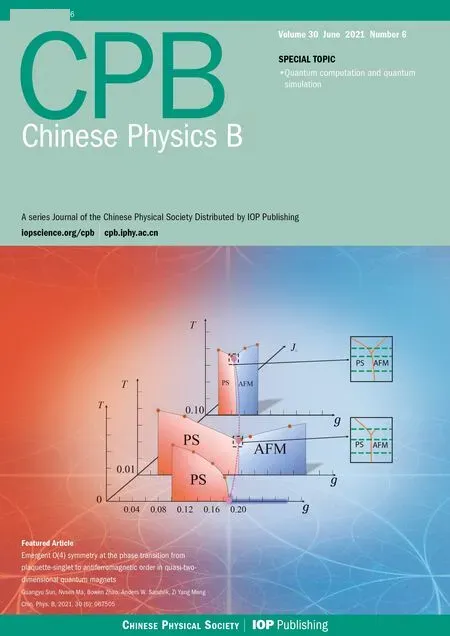Dynamics of bright soliton in a spin–orbit coupled spin-1 Bose–Einstein condensate∗
Hui Guo(郭慧) Xu Qiu(邱旭) Yan Ma(马燕)Hai-Feng Jiang(姜海峰) and Xiao-Fei Zhang(张晓斐)
1Key Laboratory of Time and Frequency Primary Standards,National Time Service Center,Chinese Academy of Sciences(CAS),Xi’an 710600,China
2School of Astronomy and Space Science,University of Chinese Academy of Sciences,Beijing 100049,China
3School of Economics and Management,Chongqing Normal University,Chongqing 401331,China
4CAS Center for Excellence and Synergetic Innovation Center in Quantum Information and Quantum Physics,University of Science and Technology of China,Shanghai 201315,China
Keywords: Bose–Einstein condensate,spin–orbit coupling,soliton
Soliton as nonlinear wave has been one of the most important research objects in nonlinear science due to its unique physical properties and potential application. In particular,with the realization of Bose–Einstein condensation(BEC)and degenerated Fermi gases in ultracold atoms,experimental and theoretical investigations show that the nonlinear atomic interactions will also result in the excitations of matter wave solitons,which have drawn enormous research interest due to the potential applications in coherent atom optics,atom interferometry and atom transport. In BEC, dark and bright solitons have been observed successively in experiments.[1–6]Recently,the MIT group has also created dark soliton and vortex soliton in ultracold Fermi gases.[7,8]
The realization of artificial spin–orbit coupling(SOC)in ultracold atoms provides a new platform to study the nonlinear matter wave solitons inside a gauge field.[9–13]Since the SOC leads to degeneracy of single-particle ground state at finite momentum,[14–22]many novel matter wave solitons can be formed,such as stripe soliton,two-dimensional(2D)composite soliton, and half-vortex gap soliton.[23–44]The Majorana fermions inside a soliton have also been predicted in Fermi superfluids with SOC.[45]On the other hand,in multi-component BEC,SOC couples different components and induce the population transfer between components,which will affect the center of mass (CoM) motion of solitons and lead to interesting dynamical evolution features.[46–51]
To further understand the effects of SOC on the dynamics of solitons, in this letter, we systematically study the dynamics of the bright solitons with a single finite momentum in the experimentally realized one-dimensional spin–orbit coupled spin-1 BEC. By defining the soliton spin and using the hyperbolic sine function as the trial function to describe a plane wave bright soliton with a single finite momentum,we first derive the motion equations of soliton’s spin and center-of-mass based on the Gross–Pitaevskii (GP) equations, which show clearly that SOC couples the soliton’s spin with its center-ofmass motion. In particular, we have obtained the exact solutions of soliton’s spin and CoM, and find that the spin oscillations caused by the exchange of atoms between components leading to a periodical oscillation of CoM. To confirm these analytical predictions, we have also solved the GP equations numerically,and find that the numerical results agree well with the analytical results.
We consider a spin-1 BEC of87Rb atom, where two counter-propagating Raman laser beams inzdirection couple|F,mF〉=|1,−1〉to|F,mF〉=|1,0〉,and couple|F,mF〉=|1,0〉level to|F,mF〉=|1,1〉. Since the linear and quadratic Zeeman energies can be tuned by using the external magnetic field and microwave dressing,[52,53]here we setting the linear Zeeman energyq=−δωwithδωbeing the frequency difference of two Raman beams, and the quadratic Zeeman energyq=−2k2Rwith the wave vectorkRof Raman beams. In this case,the single-particle Hamiltonian can be written as


Without SOC, the GP equations have exact analytical soliton solutions under the special parameters constraint.However, for our system, the SOC breaks the integrability of GP equations,it is impossible to construct the exact analytical soliton solutions.[54,55]Therefore, we employ the variational method with all parameters being time-dependent. In general,a bright soliton can be described by the hyperbolic sine function in a uniform BEC, thus for a plane wave bright soliton carrying a finite momentumkz,the variational wave functions are assumed to be

whereAmis related to the amplitude of the bright solitons in three different components and satisfying the normalized condition ∑m|Am|2=1.kzis the wave number corresponding to the average momentum of BEC,ηandzcare the width and CoM of solitons,respectively.
We further define the soliton spin as

withΨ=(ψ+,ψ0,ψ−)T, wherex,y,zis the spin operator for spin-1 BEC and the superscript†denotes the conjugate transpose.In this case,the soliton spin can be expressed as follows:

which show that the dynamics of soliton spin are completely determined by the amplitude of solitons.
Since the interacting Hamiltonianintconserves the spin([x,y,z,int]=0, where the bracket denote the commutation operation),so from the Heisenberg equation



where verifies that the soliton spin alongx,y, andzdirections are coupled by SOC and Raman coupling, unrelated to the atomic interactions.
We note that since the system is dynamical-invariant, it can be verified that the momentumkzis conserved, thus the equation(5)can be solved exactly as

anda3=Sy,0with subscript 0 being the initial value. The solution(6)shows that the spin of soliton may oscillate periodically with the frequency related to the strengths of SOC and Raman coupling.
To proceed, we derive the motion equation of soliton’s CoM by using

So after inserting the variational wave functions (3) into Eq.(7)and performing the integral in the motion equation of soliton’s CoM,we can obtain

which indicates that the spin–orbit coupling couples the soliton’s spin with its motion of center of mass. In particular,Equations (5) and (8) leads to d2zc/dt2=ΩλSy, which implies that the solitons will experience a driven force provided bySy. Consequently, we conclude that the presence of SOC will lead to interesting dynamical evolution of solitons. On the other hand,with the solution ofSzin Eq.(6),the solutions of the soliton’s CoM in Eq.(8)can also be derived exactly as

where we have assumedzc=0 att=0. It is easy to see that in the absence of SOC (λ=0), the CoM velocity is a constant,and the Raman coupling only gives rise to a well-known Rabi oscillations with frequencyΩ. While forλ/=0,the motion of soliton’s center of mass can be viewed as a superposition between the linear motion and periodical motion with frequencyω.

Figures 1 and 2 show the numerical results of GP simulations with the initial ferromagnetic solitons forkz=0 andkz/=0,respectively. A common feature shown in Figs.1 and 2 is that although the componentsm=0 andm=−1 have no solitons initially,the Raman coupling will produce bright solitons in such two components,and gives rise to the Rabi oscillation with the periodical exchange of atom among the three components. More specifically,the two cases withkz=0 andkz/=0 also show different features. Forkz=0,we haveSx=0 andω=Ω. As shown in Figs.1(e)–1(f)and Eq.(10),SyandSzoscillate periodically with frequencyω, the spin of solitons rotate periodically around an unit circle inSy–Szplane,and the solitons move periodically aroundz=0 under the action of SOC.For the case ofkz/=0, the initial soliton carries a finite momentum, it not only oscillates but also propagates alongzdirection, as shown in Fig. 2 and Eq. (9), where the motion of soliton can be viewed as a superposition between periodical and linear motions. Moreover, theSxalso oscillate with frequencyω/4 forkz/=0, and the soliton spin will rotate periodically along a closed circle in three-dimensional spin space, as shown in Fig.2(f). Last but not least, we have also chosen other initial conditions to carry out the numerical simulations, and the results show that our analytical analysis agrees well GP simulations and capture the essential physics of the dynamics of soliton in the presence of SOC.

Fig.1. The dynamical evolutions of initial ferromagnetic solitons with kz =0 under the action of SOC,where the parameters are c0 =−10,c2 =−1,λ =0.1,and Ω =0.2. Panels(a)–(c)show the evolutions of densities of three components,respectively. Panel(d)shows the evolution of total density.The red solid line and circles in panel(d)are the center-of-mass of solitons given by the numerical solutions of GP equations and the exact solutions in Eq. (9), respectively. Panel (e) shows the evolutions of Sx,y,z, the solid red, blue, and green lines represent the numerical results of Sx, Sy, and Sz,respectively,and the corresponding circles are given by exact solutions of Eq.(10),respectively. Panel(f)shows the evolution of spin in the Sy–Sz plane.In panel(g),the red,green,and blue lines represent the evolutions of particle number in the components m=+1,0,−1,respectively.

Fig.2. The dynamical evolutions of initial ferromagnetic solitons with kz=0.1 under the action of SOC,where the parameters are c0=−10,c2=−1,Ω =0.5,and λ =0.2. Panels(a)–(c)show the evolutions of densities of three components,respectively. Panel(d)shows the evolution of total density.The red solid line and circles in panel(d)are the center-of-mass of solitons given by the numerical solutions of GP equations and the exact solutions of Eq. (9), respectively. Panel (e) shows the evolutions of Sx,y,z, the solid red, blue, and green lines represent the numerical results of Sx, Sy, and Sz,respectively, and the corresponding circles are given by exact solutions of Eq. (10), respectively. Panel (f) shows the evolution of spin in the threedimensional spin space. In panel (g), the red, green, and blue lines represent the evolutions of particle number in the components m=+1,0,−1,respectively.
In summary, we have investigated the effects of SOC on the dynamics of plane wave bright solitons in spin-1 BEC.By using the hyperbolic sine function as the trial function to describe a plane wave bright soliton with a single finite momentum and defining the soliton’s average spin, we have derived the motion equations of soliton’s spin and center of mass based on the GP equations, and obtained its exact analytical solutions. Our results show that the SOC couples the soliton’s spin with its CoM coordinate effectively, the spin oscillations induced by the exchange of atoms between different components results in an effective force to drive the soliton oscillate with frequency related to the strengths of SOC and Raman coupling. Moreover,the motion of CoM of soliton can be viewed as a superposition between periodical and linear motions. Finally, we have also taken the exact ferromagnetic soliton solutions of GP equation without SOC and Raman coupling as initial wave function to solve the GP equation numerically,and the results agree well with our analytical analysis.
- Chinese Physics B的其它文章
- Quantum computation and simulation with vibrational modes of trapped ions
- ℋ∞state estimation for Markov jump neural networks with transition probabilities subject to the persistent dwell-time switching rule∗
- Effect of symmetrical frequency chirp on pair production∗
- Entanglement properties of GHZ and W superposition state and its decayed states∗
- Lie transformation on shortcut to adiabaticity in parametric driving quantum systems∗
- Controlled quantum teleportation of an unknown single-qutrit state in noisy channels with memory∗

